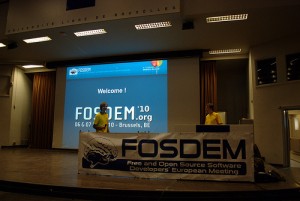Last Friday, the 1%Club held their (first, probably not last) 1%EVENT, about “international development cooperation 2.0”. I facilitated a session on “connecting the platforms”, to pave the (technical) way towards a cure for what Ushahidi’s Juliana Rotich aptly referred to as “ Data Hugging Disorder “. It resulted in a positive discussion with several people of organisations that build or host online platforms. Coming Monday, I hope the discussion continues at a meeting in The Hague about a possible Dutch IS-Hub.
 The evolution of international development cooperation in a nutshell:
The evolution of international development cooperation in a nutshell:
- first we tried to build the best water pump
- we realised we need to build the right water pump
- then we started to exchange lessons learned about building water pumps
- and now we have the Millennium Development Goals to let all water pump work contribute to a common goal (in this case: “ Target 7.C: Halve, by 2015, the proportion of people without sustainable access to safe drinking water and basic sanitation “)
“International Development Cooperation 2.0” heavily depends on using ICTs as tools for collaboration. In essence, my feeling is we’re repeating the process in building online platforms: some people still want to build the best platform, most are busy building the right platform for the situation, and (as the session proved) are getting ready to exchange the lessons we learn, and for standards to work towards common goals.
With several people in the room with (information-)technical affinity, the discussion quickly moved to open standards to choose or to develop. Although there are many concerns about privacy, identity, and security, an important breakthrough was that most of those concerns are not at all specific to the field of international development cooperation. We should make sure our concerns are documented, but more likely than not, those concerns will be addressed in some form by the big platforms. For the exchange of “actionable opportunities”, the Open Actions format is just emerging. The uncharted territory seems to be information around projects in international development.
Probably no coincidence: some of my current consultancy work is on project administration and project management solutions in such a context. Logframes are popular vehicles for project goals information, but so far I haven’t found clear patterns in how organisations deal with their projects and programmes from a management process point of view. Maybe this is the area where the conversation still needs to develop before standards can emerge.
The time is apparently right to get to standardisation: indepently, Cordaid and their platform development company have initiated a discussion on Monday about how to deal with the technical, organisational and legal aspects of sharing information and reducing redundancy for people in building up expert profiles and making them available on various platforms.
Again, this is not an area specific to international development cooperation, so hopefully a chance to benefit from the work in many other places. Not so long ago, Aldo de Moor and I visited D-CIS at Delft University, where they try to solve similar problems in a different domain: how do you create “actor-agent systems”, where software helps a crisis manager to quickly get to the right expert in the case of a disaster. How to harvest expert profiles across many fields of expertise and organisations, and also take into account that an expert is not an expert anymore after 48 hours without sleep…
As the Dutch Ministry of International Cooperation is shaking up the NGO world here in The Netherlands. “Collaboration” and “Partnerships” are the new buzz words, and since “2.0” is part of the official policy, many organisations are slightly panicing about how to move forward, and how to quickly embrace some of that “2.0”. A great time to leapfrog for the Dutch international development cooperation world.
Over the years, “accessibility” has become a standard requirement for web sites. It’s easy for a client organisation to demand compliance to a certain level of accessibility as specified in open standards. It would be great if we now can move to a similar model with levels of “data portability”, to get NGOs to add those to the requirements of their next platform.
Hopefully, Monday’s discussion is a next step towards such a standard requirement, and also offers a common road map for the platform builders. That would also open up the opportunities for BarCamps and such to join forces on implementation.
Here’s a dump of the standards mentioned at Friday’s meeting (not linked yet, but maybe one day):
- News, updates: RSS, well-accepted by now
- Identity and authentication: OpenID, OAuth
- “Social actions”: Open Actions
- Projects: Open Archive Initiative as meta-level, Dublin Core, DIDL, OpenPro
- Constituency, membership:?
- Social networks: FOAF, XFN
- Applications: Open Social, Facebook Connect?
- Payments: mobile banking? how to do payments?
- Market places:?
After an intro by Niels about the importance of open source and free software as a basis, and my intro about Social Actions, the Change The Web contest, and the emerging Open Actions format, almost all of the 25 or so attendees (note to self: build a list of participants again next time!) shared their concerns and aspirations. I have tried to write down key elements I heard, here’s the raw dump of the flip chart notes:
- How to work together? Technical standards seem feasible, pride and identity seem to get in the way.
- What are the standards we should focus on?
- Is there any form of collaboration already?
- What open standards for exchanging projects are there? Is it about project information, how to deal with quality, what about the social networking around it?
- How to get away from having profiles on many different sites?
- How to enable collaboration on many different platforms?
- How to make the collaboration itself central: from social network to collaboration network?
- For example: how to get Kiva into your project environment, rather than your project into Kiva?
- Concerns about identity, safety, privacy, security. How to keep control over where your information and identity is going?
- What formal ways are there to capture documentation?
- How to activate people who normally wouldn’t be active or interested in this context?
- Can we enable knowledge sharing through micro-blogging?
- How to guide the choice of a platform?
- How would we even define “platform”, are we all talking about the same thing when we use that word?
- Lets create best practices, compatibility, and meta standards. But: we can’t do that, “Google should do it” and “Facebook wins”.
- Types of information we could share, standards in that area we could use (see earlier in this post).
- Which platform gets what part? For instance: the business model of one platform is based on taking a percentage of the funds raised – how to deal with that when adding the fund raising feature to another platform?
For the 1%EVENT, Bart and Anna walked the talk, listened to all the suggestions made to them over time, and had two great Open Space facilitators to set up the day’s agenda. Maybe not every attendee and “poster pioneer” felt comfortable with it at once, but the co-created, slightly chaotic and creative sequence of events was precisely the kind of event I missed in The Netherlands so far!

 Racing back to Amsterdam at 270 km/h, time to consolidate my takeaways from this year’s FOSDEM in Brussels. More geeks (5,000+ expected), more lectures (200+) and more topics I wanted to follow: succeeded with OpenOffice, Drupal, and CouchDB, but not with Mozilla and XMPP. A geeky overview of my takeaways.
Racing back to Amsterdam at 270 km/h, time to consolidate my takeaways from this year’s FOSDEM in Brussels. More geeks (5,000+ expected), more lectures (200+) and more topics I wanted to follow: succeeded with OpenOffice, Drupal, and CouchDB, but not with Mozilla and XMPP. A geeky overview of my takeaways. The farmers introduced a new way of thinking: what if we could just grow our food in one place? That would save the effort of travelling around. So they started experimenting: sowing seeds, taking care of the young sprouts, trying to cultivate their plants. Until it was harvest time: reap the benefits of your labour, indulge in cornucopia for a while, store a bit, and start working on the next cycle.
The farmers introduced a new way of thinking: what if we could just grow our food in one place? That would save the effort of travelling around. So they started experimenting: sowing seeds, taking care of the young sprouts, trying to cultivate their plants. Until it was harvest time: reap the benefits of your labour, indulge in cornucopia for a while, store a bit, and start working on the next cycle. Communicating web concepts for user experience and site structure is a challenge. Wire frames and interactive prototypes are great for this, and over the years, I have been using those with many designers and developers in a variety of web projects. But creating and sharing such mockups still is a laborious task, so I went around the web again to look for a tool that truly makes that task easier.
Communicating web concepts for user experience and site structure is a challenge. Wire frames and interactive prototypes are great for this, and over the years, I have been using those with many designers and developers in a variety of web projects. But creating and sharing such mockups still is a laborious task, so I went around the web again to look for a tool that truly makes that task easier.  The evolution of international development cooperation in a nutshell:
The evolution of international development cooperation in a nutshell: